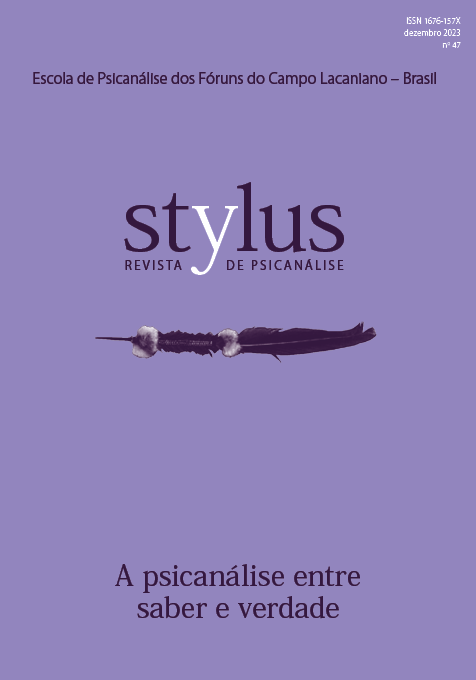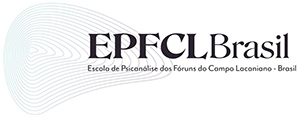"I have nothing to say, so I say"
what is possible to say as a half-truth?
DOI:
https://doi.org/10.31683/stylus.v1i47.1097Keywords:
True, Real, Knowledge, Jouissance, PassAbstract
It is impossible to say everything, or everything, because in truth it is not all because of its structure. It is only possible to semi-tell the truth, because the structure itself carries a real thing. There is a discrepancy or a fictitious marriage between knowledge and truth, because knowledge pays a dowry to marry truth because it seeks jouissance, of course. In other words, there is always an attempt to reiterate a loss of jouissance, so let us know that the truth is the heart of jouissance. The analyst attempts to access this truth, but the only possibility is semi-disclosed, since its structure is also fictional. Through these semi-tell, it is possible to go through the fundamental fantasy that creates a mark of jouissance and a value of truth by contingency. In analysis, we can build that fundamental and written fantasy that fez littoral, or seja, is trying to historisterize. There is a fundamental disagreement for every falant being: “whatever is said is forgotten behind what is said in what is heard” or “there is no sexual relationship”: there is an impossibility to write the sexual relationship, but, paradoxically, there will always be a attempt to wwrite it. Will it be a path from love to truth to love to castration? How to love that distance, that fence? It seems to us that here everything is placed at question around the pass: it is not so interesting that it appears at the end of the analysis, but not the moment of turning, of the advent of the analyst's desire, of the passage from analyzing the analyst, or of the inaugural act.
Downloads
References
Fingermann, D. (2011). A presença do passador: atualidade da Escola. Wunsch, (11).
Lacan, J. (1974). A terceira (Â. J. Ferretto, C. A. M. Garcia, G. Garcia, L. A. de Farias, M. R. C. Gil & P. C. Ramos, Trad.). Conferência pronunciada em Roma em 1o de novembro de 1974. Inédito.
Lacan, J. (1992). O seminário – livro 17: o avesso da psicanálise. Rio de Janeiro: Jorge Zahar Editor. (Trabalho original publicado em 1969-1970)
Lacan, J. (2001). Seminário: o saber do psicanalista. Publicação para circulação interna do Centro de Estudos Freudianos do Recife. Inédito. (Trabalho original publicado em 1971-1972)
Lacan, J. (2003). Proposição de 9 de outubro de 1967 sobre a formação do analista. In J. Lacan. Outros escritos (V. Ribeiro, Trad.) (p. 248). Rio de Janeiro: Zahar. (Trabalho original publicado em 1967)
Lacan, J. (2003). Lituraterra. In J. Lacan. Outros escritos (pp. 15-25). Rio de Janeiro: Jorge Zahar Editor. (Trabalho original publicado em 1971)
Lacan, J. (2008). O seminário, livro 11: os quatro conceitos fundamentais da psicanálise. Rio de Janeiro: Jorge Zahar Editor. (Trabalho original publicado em 1964)
Metzger, C. (2020). Fim de análise e passe: um comentário sobre o passador e os ecos de um real no corpo. Stylus: Revista de Psicanálise, Rio de Janeiro, (40), 171-186.
Pacheco, A. L. P. (2008). O dote que o saber paga ao gozo (la jouissance) no casamento fictício com a verdade. Textura, Rio de Janeiro, (7), 9-12.
Ramos, C. (2013). A interpretação como valor de verdade e como função poética. Stylus: Revista de Psicanálise, Rio de Janeiro, (26), 45-50.
Soler, C. (2018). Adventos do real: da angústia ao sintoma. São Paulo: Aller.
Soler, C. (2022). O passe à analista. Texto de apresentação do tema do VII Encontro Internacional da Escola de Psicanálise dos Fóruns do Campo Lacaniano. Buenos Aires. Recuperado de https://www.champlacanien.net/public/docu/4/rdv2022-ecole-argumentaire.pdf
Vilela, Y., & Iannini, G. (2016). Prefácio à edição brasileira. In Lacan, o escrito, a imagem (p. 7-22). Belo Horizonte: Autêntica.
Downloads
Published
How to Cite
Issue
Section
License
Ao encaminhar os originais, os autores cedem os direitos de publicação para STYLUS.
Os autores assumem toda responsabilidade sobre o conteúdo do trabalho, incluindo as devidas e necessárias autorizações para divulgação de dados coletados e resultados obtidos, isentando a Revista de toda e qualquer responsabilidade neste sentido.



